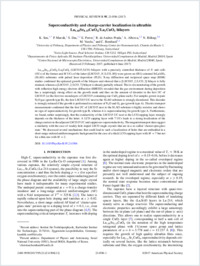Superconductivity and charge-carrier localization in ultrathin ${\mathrm{La}}_{1.85}{\mathrm{Sr}}_{0.15}{\mathrm{CuO}}_{4}/{\mathrm{La}}_{2}{\mathrm{CuO}}_{4}$ bilayers
- Sen, Kaushik University of Fribourg, Department of Physics and Fribourg Center for Nanomaterials, Fribourg, Switzerland - Institut für Festkörperphysik, Karlsruher Institut für Technologie, Eggenstein-Leopoldshafen, Germany
- Marsik, Premysl University of Fribourg, Department of Physics and Fribourg Center for Nanomaterials, Fribourg, Switzerland
- Das, Saikat University of Fribourg, Department of Physics and Fribourg Center for Nanomaterials, Fribourg, Switzerland - Department of Physics and Astronomy, Seoul National University (SNU), Seoul, Korea
- Perret, Edith University of Fribourg, Department of Physics and Fribourg Center for Nanomaterials, Fribourg, Switzerland
- Andrés Prada, R. de University of Fribourg, Department of Physics and Fribourg Center for Nanomaterials, Fribourg, Switzerland
- Alberca, Aurora University of Fribourg, Department of Physics and Fribourg Center for Nanomaterials, Fribourg, Switzerland - Swiss Light Source, Paul Scherrer Institut, Villigen PSI, Switzerland
- Biškup, N. Departamento de Física Aplicada III, Instituto Pluridisciplinar, Universidad Complutense de Madrid, Spain - Centro Nacional de Microscopía Electrónica, Universidad Complutense de Madrid, Spain
- Varela, M. Departamento de Física Aplicada III, Instituto Pluridisciplinar, Universidad Complutense de Madrid, Spain
- Bernhard, Christian University of Fribourg, Department of Physics and Fribourg Center for Nanomaterials, Fribourg, Switzerland
-
06.06.2017
Published in:
- Physical Review B. - 2017, vol. 95, no. 21, p. 214506
English
La1.85Sr0.15CuO4/La2CuO4 (LSCO15/LCO) bilayers with a precisely controlled thickness of N unit cells (UCs) of the former and M UCs of the latter ([LSCO15_N/LCO_M]) were grown on (001)-oriented SrLaAlO4 (SLAO) substrates with pulsed laser deposition (PLD). X-ray diffraction and reciprocal space map (RSM) studies confirmed the epitaxial growth of the bilayers and showed that a [LSCO15_2/LCO_2] bilayer is fully strained, whereas a [LSCO15_2/LCO_7] bilayer is already partially relaxed. The in situ monitoring of the growth with reflection high energy electron diffraction (RHEED) revealed that the gas environment during deposition has a surprisingly strong effect on the growth mode and thus on the amount of disorder in the first UC of LSCO15 (or the first two monolayers of LSCO15 containing one CuO2 plane each). For samples grown in pure N2O gas (growth type B), the first LSCO15 UC next to the SLAO substrate is strongly disordered. This disorder is strongly reduced if the growth is performed in a mixture of N2O and O2 gas (growth type A). Electric transport measurements confirmed that the first UC of LSCO15 next to the SLAO substrate is highly resistive and shows no sign of superconductivity for growth type B, whereas it is superconducting for growth type A. Furthermore, we found, rather surprisingly, that the conductivity of the LSCO15 UC next to the LCO capping layer strongly depends on the thickness of the latter. A LCO capping layer with 7 UCs leads to a strong localization of the charge carriers in the adjacent LSCO15 UC and suppresses superconductivity. The magnetotransport data suggest a similarity with the case of weakly hole doped LSCO single crystals that are in a so-called ‘cluster-spin-glass state.’ We discussed several mechanisms that could lead to such a localization of holes that are embedded in a short-range ordered antiferromagnetic background for the case of a thick LCO capping layer with M=7 but not for a thin one with M=2.
- Faculty
- Faculté des sciences et de médecine
- Department
- Département de Physique
- Language
-
- English
- Classification
- Physics
- License
- License undefined
- Identifiers
-
- RERO DOC 305126
- DOI 10.1103/PhysRevB.95.214506
- Persistent URL
- https://folia.unifr.ch/unifr/documents/306058
Statistics
Document views: 115
File downloads:
- ber_scc.pdf: 132
